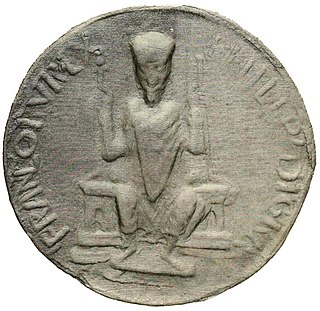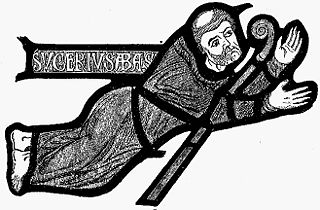
Louis VII, called the Younger or the Young to differentiate him from his father Louis VI, was king of France from 1137 to 1180. His first marriage was to Duchess Eleanor of Aquitaine, one of the wealthiest and most powerful women in western Europe. The marriage temporarily extended the Capetian lands to the Pyrenees.

The Basilica of Saint-Denis is a large former medieval abbey church and present cathedral in the commune of Saint-Denis, a northern suburb of Paris. The building is of singular importance historically and architecturally as its choir, completed in 1144, is widely considered the first structure to employ all of the elements of Gothic architecture.

Philip I, called the Amorous, was King of the Franks from 1060 to 1108. His reign, like that of most of the early Capetians, was extraordinarily long for the time. The monarchy began a modest recovery from the low it had reached during the reign of his father, Henry I, and he added the Vexin region and the viscountcy of Bourges to his royal domaine.

Robert II, called the Pious or the Wise, was King of the Franks from 996 to 1031, the second from the Capetian dynasty. Crowned Junior King in 987, he assisted his father on military matters. His solid education, provided by Gerbert of Aurillac in Reims, allowed him to deal with religious questions of which he quickly became the guarantor. Continuing the political work of his father, after becoming sole ruler in 996, he managed to maintain the alliance with the Duchy of Normandy and the County of Anjou and thus was able to contain the ambitions of Count Odo II of Blois.

Suger was a French abbot and statesman. He was a key advisor to King Louis VI and his son Louis VII, acting as the latter's regent during the Second Crusade. His writings remain seminal texts for early twelfth-century Capetian history, and his reconstruction of the Basilica of Saint-Denis where he was abbot was instrumental in the creation of Gothic architecture.

Denis of France was a 3rd-century Christian martyr and saint. According to his hagiographies, he was bishop of Paris in the third century and, together with his companions Rusticus and Eleutherius, was martyred for his faith by decapitation. Some accounts placed this during Domitian's persecution and incorrectly identified St Denis of Paris with the Areopagite who was converted by Paul the Apostle and who served as the first bishop of Athens. Assuming Denis's historicity, it is now considered more likely that he suffered under the persecution of the emperor Decius shortly after AD 250.

Beauvais is a town and commune in northern France, and prefecture of the Oise département, in the Hauts-de-France region, 75 kilometres north of Paris.
Eudes, French for Odo, may refer to:

The Diocese of Beauvais, Noyon, and Senlis is a Latin Church ecclesiastical territory or diocese of the Catholic Church in France. The diocese encompasses the department of Oise in the region of Hauts-de-France. The diocese is a suffragan of the metropolitan Archdiocese of Reims. The current bishop is Jacques Benoit-Gonnin, appointed in 2010.

Robert I of Dreux, nicknamed the Great, was the fifth son of Louis VI of France and Adélaide de Maurienne.
Odo is a name typically associated with historical figures from the Middle Ages and before. Odo is etymologically related to the names Otho and Otto, and to the French name Odon and modern version Eudes, and to the Italian names Ottone and Udo; all come from the Germanic word ot meaning "possessor of wealth".

The Diocese of Bayeux and Lisieux is a Latin Church diocese of the Catholic Church in France. It is coextensive with the Department of Calvados and is a suffragan to the Archdiocese of Rouen, also in Normandy.

Saint Fulrad was a French religious leader who was the Abbot of Saint-Denis. He was the counselor of both Pepin the Short and Charlemagne. Historians see Fulrad as important due to his significance in the rise of the Frankish Kingdom, and the insight he gives into early Carolingian society. He was noted to have been always on the side of Charlemagne, especially during the attack from the Saxons on Regnum Francorum, and the Royal Mandatum. Other historians have taken a closer look at Fulrad's interactions with the papacy. When Fulrad was the counselor of Pepin he was closely in contact with the papacy to gain approval for Pepin's appointment as King of the Franks. During his time under Charlemagne, he had dealings with the papacy again for different reasons. When he became Abbot of Saint-Denis in the mid-eighth century, Fulrad became important in the lives of distinct historical figures in various ways. Saint Fulrad's Feast Day is on 16 July.

Saint Lucian of Beauvais is a Christian martyr of the Catholic Church, called the "Apostle of Beauvais." He was killed in the 3rd century during the Diocletian persecution, although later traditions make him a martyr of the 1st century instead. This was because the church of Beauvais attempted to claim apostolic origins for itself. Odo, bishop of Beauvais during the 9th century, was the first writer to designate Lucien as the first bishop of Beauvais.

The accession of the king of France to the royal throne was legitimized by a ceremony performed with the Crown of Charlemagne at the Reims Cathedral. In late medieval and early modern times, the new king did not need to be anointed in order to be recognized as French monarch but ascended upon the previous monarch's death with the proclamation "Le Roi est mort, vive le Roi!"

Odo I was a West Frankish prelate who served as abbot of Corbie in the 850s and as bishop of Beauvais from around 860 until his death in 881. He was a courtier and a diplomat, going on missions to East Francia and the Holy See.
Odo of Beauvais may refer to
Odo III was the bishop of Beauvais from 1144 until his death. Before becoming bishop, he was the Benedictine abbot of the monastery of Saint-Symphorien.
Philip of France was a Capetian prince and archdeacon of Paris.

Gothic cathedrals and churches are religious buildings created in Europe between the mid-12th century and the beginning of the 16th century. The cathedrals are notable particularly for their great height and their extensive use of stained glass to fill the interiors with light. They were the tallest and largest buildings of their time and the most prominent examples of Gothic architecture. The appearance of the Gothic cathedral was not only a revolution in architecture; it also introduced new forms in decoration, sculpture, and art.














